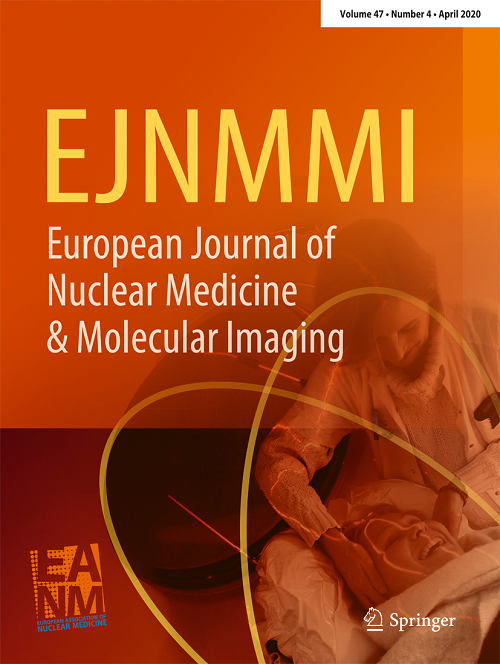DOTAGA.Glu的临床前评价(FAPI)2和DO3A.Glu。(FAPI)2作为治疗药物与人体剂量外推对镥-177和铽-161类似物。
IF 7.6
1区 医学
Q1 RADIOLOGY, NUCLEAR MEDICINE & MEDICAL IMAGING
European Journal of Nuclear Medicine and Molecular Imaging
Pub Date : 2025-10-17
DOI:10.1007/s00259-025-07565-9
引用次数: 0
摘要
目的评价DOTAGA.Glu的药理作用。(FAPI)2和DO3A.Glu。(FAPI)2,专门作为开发治疗性FAPI靶向放射配体的前体。(FAPI)2和DO3A.Glu。(FAPI)2分别用镓-68和镥-177进行放射性标记,然后对FAP+ CAFs进行体外(亲脂性、蛋白结合、饱和度、内化和外化)研究。在体内(生物分布、代谢稳定性、血液动力学、PET/SPECT/CT成像)和离体(放射自显影、免疫组织化学)对pc3小鼠进行了研究。小鼠剂量测量数据外推到人类估计。结果所有放射配体的放射化学纯度均达到98%以上,具有较高的FAP亲和力(Kd:0.7 ~ 0.9 nM)和快速内化的cas,在亲脂性和血清蛋白结合方面存在差异。在体内研究中,对[68Ga]Ga-DOTAGA.Glu。(FAPI)2和[68Ga]Ga-DO3A.Glu。(FAPI)2显示高且持续的肿瘤摄取高达3 h p.i. (18-19%I.A./g)。陆[177]Lu-DOTAGA.Glu。(FAPI)2和[177Lu]Lu-DO3A.Glu。(FAPI)2肿瘤摄取在4 h时分别为16.2±2.5和15±1.2% IA/g,在48 h时分别为5.1±0.1和2.8±0.4%IA/g。所有放射性配体均表现出低血潴留水平。PET/SPECT/CT成像证实高肿瘤与背景比。摄取模式与pc3小鼠体内异质FAP分布的放射自显影图像密切相关,而小鼠和人类的FAP在pc3肿瘤中的检测通过免疫组织化学证实。[177Lu]的外推人体吸收剂量估计(Gy/GBq)(FAPI)2与[177Lu]Lu-DO3A.Glu.(FAPI)2相比,在大多数器官中普遍较高。人体外推的161tb标记的放射性配体在组织中的吸收剂量比177lu标记的配体平均高38%。结论这些结果支持DOTAGA.Glu的潜在临床翻译。(FAPI)2和DO3A.Glu。(FAPI)2,作为精确诊断和治疗表达fap的恶性肿瘤的有希望的候选者。本文章由计算机程序翻译,如有差异,请以英文原文为准。
Preclinical evaluation of DOTAGA.Glu.(FAPI)2 and DO3A.Glu.(FAPI)2 as theranostics with human dosimetry extrapolation to lutetium-177 and terbium-161 analogs.
PURPOSE
This study aims to assess DOTAGA.Glu.(FAPI)2 and DO3A.Glu.(FAPI)2, specifically engineered as precursors for the development of theranostic FAPI-targeted radioligands.
METHODS
DOTAGA.Glu.(FAPI)2 and DO3A.Glu.(FAPI)2 were radiolabeled with gallium-68 and lutetium-177, followed by in vitro (lipophilicity, protein binding, saturation, internalization and externalization) studies on FAP+ CAFs. In vivo (biodistribution, metabolic stability, blood kinetics, PET/SPECT/CT imaging) and ex vivo, (autoradiography, immunohistochemistry) conducted on PC3-mice. Murine dosimetry data were extrapolated to human estimates.
RESULTS
All radioligands achievied > 98% radiochemical purity, demonstrating high FAP affinity (Kd:0.7-0.9 nM) and rapid internalization in CAFs, with differences in lipophilicity and serum protein binding. In vivo studies, for [68Ga]Ga-DOTAGA.Glu.(FAPI)2 and [68Ga]Ga-DO3A.Glu.(FAPI)2 showed high and sustained tumor uptake up to 3 h p.i. (18-19%I.A./g). For [177Lu]Lu-DOTAGA.Glu.(FAPI)2 and [177Lu]Lu-DO3A.Glu.(FAPI)2 tumor uptake was 16.2 ± 2.5 and 15 ± 1.2% IA/g at 4 h p.i., reaching 5.1 ± 0.1 and 2.8 ± 0.4%IA/g at 48 h, respectively. All radioligands exhibited low blood retention levels. PET/SPECT/CT imaging confirmed high tumor-to-background ratios. Uptake patterns correlate well with autoradiography images of heterogeneous FAP distribution in PC3-mice, while the detection of both murine and human FAP in PC3-tumors was demonstrated through immunohistochemistry. The extrapolated human absorbed dose estimates (Gy/GBq) for [177Lu]Lu-DOTAGA.Glu.(FAPI)2 were generally higher across most organs compared to [177Lu]Lu-DO3A.Glu.(FAPI)2. Human extrapolation of the 161Tb-labeled radioligands delivered on average ~ 38% higher absorbed doses in tissues as compared to their 177Lu-labeled counterparts.
CONCLUSION
These results support the potential clinical translation of DOTAGA.Glu.(FAPI)2 and DO3A.Glu.(FAPI)2, as promising candidates for precise diagnosis and treatment of FAP-expressing malignancies.
求助全文
通过发布文献求助,成功后即可免费获取论文全文。
去求助
来源期刊
CiteScore
15.60
自引率
9.90%
发文量
392
审稿时长
3 months
期刊介绍:
The European Journal of Nuclear Medicine and Molecular Imaging serves as a platform for the exchange of clinical and scientific information within nuclear medicine and related professions. It welcomes international submissions from professionals involved in the functional, metabolic, and molecular investigation of diseases. The journal's coverage spans physics, dosimetry, radiation biology, radiochemistry, and pharmacy, providing high-quality peer review by experts in the field. Known for highly cited and downloaded articles, it ensures global visibility for research work and is part of the EJNMMI journal family.

 求助内容:
求助内容: 应助结果提醒方式:
应助结果提醒方式:


